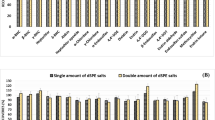Abstract
Two new specific, selective, simple and inexpensive spectroscopic methods for estimating a trace amount of chromium (Cr3+) from a multi-vitamin with multi-mineral pharmaceutical formulations were developed. The proposed methods are based on the conversion of Cr3+ to Cr6+ either by oxidation with a nitric acid–perchloric acid mixture (method I) or by fusion with an excess amount of sodium carbonate (method II), followed by the complexation of Cr6+ with 1,5-diphenylcarbazide (DPC) in a mineral acidic solution of pH 1.0 ± 0.5. The pink-colored complex was estimated at 544 nm. Both methods were found to be linear in the range of 0.1–0.8 µg/ml with a limit of detection in the range of 0.0123–0.0157 µg/ml and a limit of quantitation in the range of 0.0419–0.0525 µg/ml. Method I was found to be suitable for estimating Cr3+ species in various formulations, like tablets, capsules and syrups, while method II was found to be suitable for tablets and capsules. Satisfactory recovery from spiked samples of standard Cr3+ suggests no interference of any excipients and diverse ions present in the formulations. The developed methods were compared with AAS by ANOVA, and no significant difference was observed.
Similar content being viewed by others
References
S. A. Ketz and H. Salem, “The Biological and Environmental Chemistry of Chromium”, 1994, VCH, New York, 43.
M. Stoeppler, “Hazardous Metals in the Environment: Techniques and Instrumentation in Analytical Chemistry”, 1992, Elsevier, Amesterdam, 373.
IARC, “IARC Monographs of the Evaluation of the Carcinogenic Risk of Chemicals to Humans: Chromium, Nickel and Welding”, 1990, International Agency for Research on Cancer, Lyon.
USEPA 600/8–83–014F, “Health Assesment Document for Chromium”, 1984, US Environmental Protection Agency, Washington, D.C.
T. S. Burenko, L. P. Artem’eva, and G. D. Vlasova, Gig. Tr. Prof. Zabol., 1989, 9, 46.
N. Hara, Ind. Health, 1986, 24, 41.
S. Divakaran, L. G. Obaldo, and I. P. Forster, J. Agric. Food Chem., 2002, 50, 464.
T. Dutkiewicz, J. Konczalik, and M. Przechera, Acta Pol. Pharm., 1969, 26, 165.
W. Matczak, T. Rogaczewska, and J. T. Solnica, Med. Pr., 1986, 37, 197.
Y. Q. Li, Y. H. Zhao, Y. H. Cao, and M. Z. Shao, Hua. Xi Yi Ke Da Xue Xue Bao., 1989, 20, 85.
G. H. Zhu, Zho. Yu Fang Yi Xue Za Zhi, 1984, 18, 173.
W. J. Smith, M. A. Johnston, and A. R. Lea, J. Pharm. Pharmacol., 1984, 36, 687.
“United States Pharmacopeia, USP-25/NF-20”, 2002, Authority of the United States Pharmacopeial Convention, Washington, D.C., 2460.
E. B. Sandell, “Colorimetric Determination of Traces of Metals”, 1959, Intersciences, New York, 388.
A. D. Eaton, L. S. Clesceri, and A. E. Greenberg, “Standard Methods for the Examination of Water and Water Waste”, 1985, American Public Health Association, American Water Works Association, Water Pollution Control Federation, Washington D.C., 201.
USEPA Method 7196A, “Test Methods for Evaluating Solid Waste”, 1990, US Environmental Protection Agency, US Government Printing Office, Washington, D.C.
NIOSH, “NIOSH Manual of Analytical Methods”, 1994, National Institute for Occupational Safety and Health, Cincinnati.
USEPA Method 3060A, “Alkaline Digestion for Hexavalent Chromium”, 1996, US Environmental Protection Agency, US Government Printing Office, Washington, D.C.
OSHA, “Hexavalent Chromium in Workplace Atmosphere”, 1998, Occupational Safety and Health Association, US Department of Labor, Washington, D.C.
Author information
Authors and Affiliations
Corresponding author
Rights and permissions
About this article
Cite this article
Sankalia, J.M., Mashru, R.C., Sankalia, M.G. et al. Estimation of Trace Amounts of Chromium(III) in Multi-Vitamin with Multi-Mineral Formulations. ANAL. SCI. 20, 1321–1325 (2004). https://doi.org/10.2116/analsci.20.1321
Received:
Accepted:
Published:
Issue Date:
DOI: https://doi.org/10.2116/analsci.20.1321




